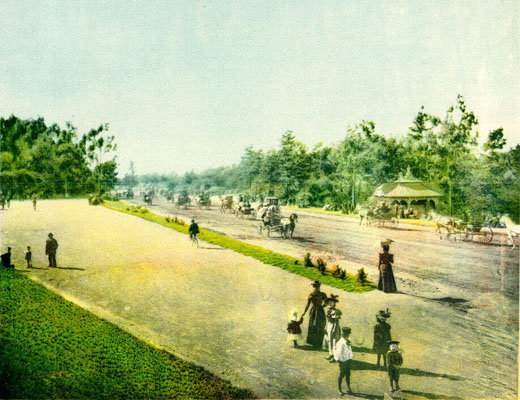
Apple cider press statue in Golden Gate Park by Thomas Shields-Clarke, 1892 (sketch by Heath Massey)
For some reason I always assumed this sculpture was about wine. That muscled, bare-footed figure evokes for me a beautiful Greek god (Dionysus, Greek god of wine?). Even on a typical foggy day in the park, he conjures a warm day in late summer, the grape harvest, abandonment to the pleasures of the vine. Wrong! Those are actually apples scattered around the base of the sculpture, which actually depicts a cider press. Perhaps that’s because the sculptor, Thomas Shields-Clarke was from Pittsburgh, Pennsylvania where apples are no doubt much more common than grapes, especially in 1892 when this statue was made? It was cast in Paris though, (by Jaboeuf and Bezout) so maybe that’s where it picked up the whiff of wine? In any case, Michael de Young and the Midwinter Fair Commission purchased it and exhibited it at the Midwinter Fair in 1894. It was originally a drinking fountain, but the metal cup that used to be attached by a chain disappeared long ago, along with the water.
Which set me to wondering about when and where public drinking fountains were invented. Turns out modern, sanitary drinking fountains first appeared in public spaces in this country in the early 1900s and two inventors apparently share credit. Halsey Taylor, in Ohio, developed a fountain prototype after his father died of typhoid, which he contracted after drinking contaminated water. Around the same time Luther Haws, a part time plumber and sanitary inspector in Berkeley, developed a faucet designed for drinking after inspecting a public school and seeing children sharing a tin cup attached to a fountain. The Halsey Taylor Company and the Haws Company are still prominent in the public drinking fountain business.


Your vision is incredible, and I love reading the “rest of the story” and background about your subjects. Another great sketch! Thank you for sharing!!
I don’t recall seeing that sculpture in the park. Can you describe where it is so I can look for it next time I’m there?
Fascinating history of drinking fountains. Always amazing to learn how new everything is!
This sculpture is in the Music Concourse on the De Young side, right across the street from the Pool of Enchantment.
Wonderful!! Love the sketch and the story (and Pittsburgh origin, no less!)
Reblogged this on Seen and commented:
I love the fascinating history and lovely drawings that Heath Massey includes in her blog on Golden Gate Park. And … I look forward to her upccoming talk, “Artists in Golden Gate Park,” at Canessa Gallery, Wednesday September 24, 7 p.m. The gallery is at 708 Montgomery Street in San Francisco, steps away from the Transamerica Pyramid building. My show “Welcome to Fogland” will be open for viewing for an hour before the talk. Stop by for some treats, some sparkling … yes … cider! … and Heath’s wonderful talk.
Actually it should be no surprise that an apple press is depicted in San Francisco in 1892. At that time the average SF family consumed more hard cider (yes, the alcoholic version of apple juice now mistakenly referred to as cider) than water, beer or wine. This is because apple juice did not keep well without refrigeration (it would spontaneously ferment) and the water was not reliably clean. However a drink that is at least 2% alcohol kills most pathogens. As a result California had large acreage of apples mostly devoted to producing cider which settlers had been fermenting for home consumption since they left the East Coast.
Johnny Appleseed was in fact a successful entrepreneur who established (hard) cider orchards ahead of settlers and sold them to the new arrivals. He was growing trees not for eating but planting “spitters” that were good for fermentation for the production of a healthy and refreshing (if pleasantly alcoholic) drink.
Beer and breweries were a later arrival as a result of the influence of German settlers. Wine of course arrived early with the Spanish Missionaries but was more expensive than cider.
It is interesting to see the popularity of “hard” cider booming in the US. Although it is a “new” trend, it is in fact the earliest alcoholic drink produced by Europeans in the US with a strong and old tradition. Apple trees and seed were amongst the very first plants brought from Europe to the American continent.
Thanks greeat blog post